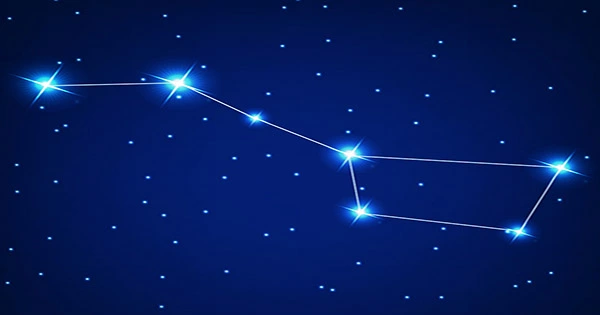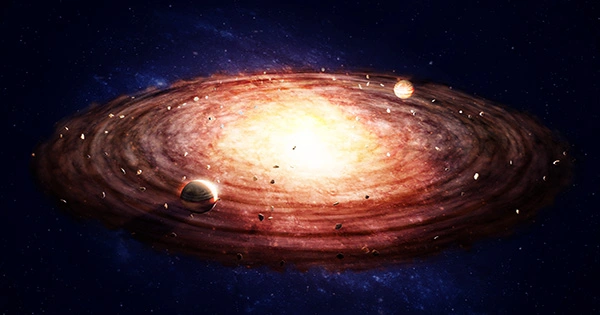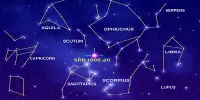Ursa Major, often known as the Great Bear in the northern hemisphere, is the largest constellation in the sky. It is the third-largest of the sky’s 88 constellations.
The name is Latin for “greater she-bear.” When compared to adjacent Ursa Minor, which is known as the lesser bear, Ursa Major is known as the greater (or larger) bear.
Ptolemy recognized 48 constellations in the second century CE, including Ursa Major. The Big Dipper asterism, often known as the Plough, is formed by the brightest stars in this constellation. This asterism is one of the most easily recognized shapes in the sky.
The Big Dipper and the Polaris star are depicted on the Alaska flag.
Ursa Major’s Prominent Stars
Ursa Major is home to several notable stars. The asterism generated by the constellation’s seven major stars is the most well-known feature of the constellation.
- Big Dipper Stars:
- Alkaid
- Mizar
- Alioth
- Megrez
- Phecda
- Merak
- Dubhe
Despite the fact that this region of the constellation represents the Great Bear’s hind legs and tail, these dazzling stars make the eye-catching image of a ladle. Two brilliant stars in this asterism can be utilized as navigational markers. Dubhe and Merak are the names of these two stars. They indicate the location of Polaris, the current northern pole star.
Polaris is the northern star in the Ursa Minor constellation. Dubhe is also known as Alpha Ursae Majoris. Dubhe is an orange massive star located approximately 120 light-years from Earth. With a magnitude of 1.79, it is the second brightest star in the constellation.
Dubhe is the sky’s 35th brightest star. Ursae Majoris is another name for Merak. It has a magnitude of 2.37 and is a white star. That is around three times our sun’s mass and radius.
Merak’s surface temperatures are nearly twice that of our sun.
The Alkaid star, commonly known as Eta Ursae Majoris, is the tail of the Great Bear. Also known as the Big Dipper’s handle tip. It looks like a bluish-white star. It has a magnitude of 1.85 and surface temperatures that are approximately three times hotter than our sun. Alkaid is Ursa Major’s third brightest star.
Mizar-Alcor, also known as Zeta Ursae Majoris, is the second star from the end of the tail or handle. It is the fourth brightest star in the constellation. Mizar, along with its companion Alcor, forms a well-known double star. These two stars were known as the horse and rider by the Arabs. The ability to see these two stars with the unaided eye was commonly regarded as a test of good eyesight among them.
Alioth, also known as Epsilon Ursae Majoris, is the third star. The brightest star in the Ursa Major constellation is Alioth. It has a magnitude of 1.76 and is the 33rd brightest star in the sky. It is around 80 light-years away from Earth.
Megrez, also known as Delta Ursae Majoris, is the fourth star. Megrez is found at the intersection of the bear’s torso and tail, or the dipper’s ladle and handle. It is a white star about 60 light-years away from Earth.
Following Megrez is the star Dubhe, which completes the top frame of the dipper. Merak is the star that defines the dipper’s bottom. Phecda, commonly known as Gamma Ursae Majoris, completes the dipper’s bottom frame. Phecda, a white star with a magnitude of 2.44, is visible in the night sky.
Muscida is the star that sits atop the bear’s head. Omicron Ursae Majoris is another name for this star. It is a yellow massive star located approximately 180 light-years from Earth.
Talitha is the star at the bear’s forelegs. It is known as Lota Ursae Majoris. This star belongs to a four-star system. It features two binary star systems located approximately 45 light-years from Earth.
The bear’s hind legs contain the remaining stars. Tania Borealis, Tania Australis, Alula Borealis, and Alula Australis are the names of these stars.
Tania Borealis is a white star 140 light-years away from Earth. Tania Australis is a red giant star located around 240 light-years from Earth.
The Alula Borealis is an orange giant located approximately 400 light-years from Earth. The Alula Australis system has four stars. It is made up of two pairs of binary stars. These stars are 30 light-years away from us. The primary stars in this system are similar to sun stars. The others are classified as red dwarfs.















